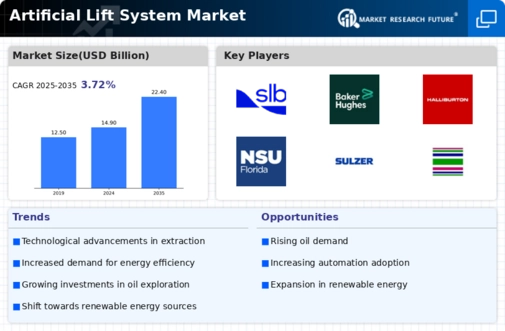Market Growth Projections
The Global Artificial Lift System Market Industry is poised for substantial growth, with projections indicating a market value of 14.9 USD Billion in 2024 and an anticipated increase to 22.4 USD Billion by 2035. This growth trajectory suggests a compound annual growth rate of 3.81% from 2025 to 2035. The driving forces behind this expansion include rising oil production demands, technological advancements, and regulatory support for energy production. As the industry adapts to changing market dynamics and seeks innovative solutions to enhance recovery rates, the artificial lift systems market is likely to evolve, reflecting the ongoing transformation within the global energy landscape.
Technological Advancements
Technological advancements are a key driver in the Global Artificial Lift System Market Industry, as innovations in equipment and techniques enhance operational efficiency and reduce costs. The introduction of smart technologies, such as IoT and AI, allows for real-time monitoring and predictive maintenance, which can significantly improve the performance of artificial lift systems. These advancements not only optimize production but also extend the lifespan of equipment. As a result, operators are increasingly adopting these technologies to remain competitive in a challenging market. The ongoing evolution of artificial lift systems is likely to contribute to a compound annual growth rate of 3.81% from 2025 to 2035.
Rising Exploration Activities
The Global Artificial Lift System Market Industry is bolstered by rising exploration activities in untapped oil and gas reserves. As companies seek to maximize production from existing fields and explore new ones, the demand for artificial lift systems increases. Enhanced recovery techniques are essential in challenging environments, such as deepwater and unconventional reservoirs, where traditional methods may fall short. This trend is particularly evident in regions like the Middle East and North America, where significant investments are being made in exploration. The focus on maximizing output from these fields is likely to drive the market further, ensuring sustained growth in the coming years.
Increasing Oil Production Demand
The Global Artificial Lift System Market Industry is experiencing a surge in demand due to the increasing need for oil production. As global energy consumption rises, particularly in developing economies, the necessity for efficient extraction methods becomes paramount. Artificial lift systems play a crucial role in enhancing oil recovery rates, thereby supporting the industry's growth. In 2024, the market is projected to reach 14.9 USD Billion, reflecting the industry's response to heightened production requirements. This trend is expected to continue, with the market anticipated to grow to 22.4 USD Billion by 2035, indicating a robust demand for artificial lift technologies.
Growing Demand for Enhanced Oil Recovery
The growing demand for enhanced oil recovery (EOR) techniques is a pivotal factor influencing the Global Artificial Lift System Market Industry. As conventional oil reserves deplete, operators are turning to EOR methods to extract additional hydrocarbons from mature fields. Artificial lift systems are integral to these processes, enabling the efficient recovery of oil that would otherwise remain untapped. The market's expansion is evident as companies invest in technologies that facilitate EOR, ensuring they can meet the rising global energy demands. This trend is expected to sustain the market's growth trajectory, aligning with the projected increase in market value to 22.4 USD Billion by 2035.
Regulatory Support for Energy Production
Regulatory support for energy production is a significant driver of the Global Artificial Lift System Market Industry. Governments worldwide are implementing policies that encourage the development of oil and gas resources, which often includes the adoption of artificial lift technologies. Incentives such as tax breaks, subsidies, and streamlined permitting processes facilitate investment in advanced extraction methods. This regulatory environment not only supports existing operations but also attracts new players to the market. As nations strive to achieve energy independence and sustainability, the role of artificial lift systems becomes increasingly vital, further propelling market growth.






















